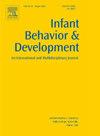Soothing touch matters: Patterns of everyday mother-infant physical contact and their real-time physiological implications
IF 2
3区 心理学
Q3 PSYCHOLOGY, DEVELOPMENTAL
引用次数: 0
Abstract
Physical contact between infants and caregivers is crucial for attachment development. Previous research shows that skin-to-skin contact after birth and frequent baby wearing in the first year predict secure attachment at 12-months. This relationship is thought to be mediated by the activation of infants' parasympathetic nervous system through caregiver touch. However, little is known about everyday touch behaviors and their impact on infants' real-time parasympathetic activity. Laboratory observations may not accurately represent real-world interactions, highlighting the need for ecologically valid studies. To address this, we examined everyday dyadic touch behaviors and their real-time effects on infant parasympathetic activation. We video recorded N = 28 infants (1–10 months old) and their mothers at home for behavioral analyses. All infants wore wireless ECG sensors (1024 Hz) during video recordings, and n = 21 infants had high-quality ECG data that could be used for Respiratory Sinus Arrhythmia analyses. We used a dynamic measure of RSA (updated every 200 ms) as an index for real-time parasympathetic activation. We found that dyads touch interactions at home involve short, though highly variable bouts of physical contact, that change with infant age. Younger infants spent more time remaining stationary during contact and receiving more soothing touch compared to older infants. Only soothing touch – i.e., rocking, patting, bouncing, or stroking– led to immediate, significant increases in parasympathetic activity (RSA), and this effect was driven by younger infants. This study provides new insights into the ecological patterns of touch in early development and the biobehavioral mechanisms promoting secure attachment.
舒缓的触摸很重要:日常母婴身体接触的模式及其实时生理含义。
婴儿和照顾者之间的身体接触对依恋发展至关重要。先前的研究表明,出生后的皮肤接触和第一年频繁的婴儿穿戴预示着12个月大时的安全依恋。这种关系被认为是通过照顾者的触摸激活婴儿的副交感神经系统介导的。然而,人们对日常触摸行为及其对婴儿实时副交感神经活动的影响知之甚少。实验室观察可能不能准确地代表现实世界的相互作用,强调需要生态有效的研究。为了解决这个问题,我们研究了日常的二元触摸行为及其对婴儿副交感神经激活的实时影响。我们对N = 28名婴儿(1-10个月大)和他们的母亲在家中进行录像,进行行为分析。所有婴儿在录像时都佩戴无线ECG传感器(1024 Hz), n = 21名婴儿有高质量的ECG数据,可用于呼吸窦性心律失常分析。我们使用RSA的动态测量(每200 ms更新一次)作为实时副交感神经激活的指标。我们发现,在家里,二人的接触互动包括短暂的、但变化很大的身体接触,这种接触随着婴儿年龄的增长而变化。与年龄较大的婴儿相比,年龄较小的婴儿在接触时保持静止的时间更长,并且得到更多舒缓的触摸。只有安抚性的触摸——比如摇晃、拍打、弹跳或抚摸——会导致副交感神经活动(RSA)立即显著增加,而且这种效果是由年龄较小的婴儿驱动的。本研究为早期发育过程中触觉的生态模式和促进安全依恋的生物行为机制提供了新的见解。
本文章由计算机程序翻译,如有差异,请以英文原文为准。
求助全文
约1分钟内获得全文
求助全文
来源期刊

Infant Behavior & Development
PSYCHOLOGY, DEVELOPMENTAL-
CiteScore
4.10
自引率
4.80%
发文量
94
期刊介绍:
Infant Behavior & Development publishes empirical (fundamental and clinical), theoretical, methodological and review papers. Brief reports dealing with behavioral development during infancy (up to 3 years) will also be considered. Papers of an inter- and multidisciplinary nature, for example neuroscience, non-linear dynamics and modelling approaches, are particularly encouraged. Areas covered by the journal include cognitive development, emotional development, perception, perception-action coupling, motor development and socialisation.
 求助内容:
求助内容: 应助结果提醒方式:
应助结果提醒方式:


